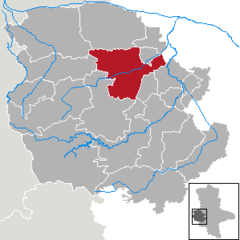Halberstadt | |
|---|---|
Liebfrauenkirche St. Martini Timber framed houses in the city centre Cathedral treasure Halberstadt city centre | |
Location of Halberstadt within Harz district  | |
| Coordinates: 51°53′45″N 11°2′48″E / 51.89583°N 11.04667°E | |
| Country | Germany |
| State | Saxony-Anhalt |
| District | Harz |
| Subdivisions | 7 Ortschaften |
| Government | |
| • Mayor (2020–27) | Daniel Szarata[1] (CDU) |
| Area | |
| • Total | 142.97 km2 (55.20 sq mi) |
| Elevation | 119 m (390 ft) |
| Population (2022-12-31)[2] | |
| • Total | 40,457 |
| • Density | 280/km2 (730/sq mi) |
| Time zone | UTC+01:00 (CET) |
| • Summer (DST) | UTC+02:00 (CEST) |
| Postal codes | 38820 |
| Dialling codes | 03941 |
| Vehicle registration | HZ, HBS, QLB, WR |
| Website | www.halberstadt.de |
Halberstadt (Eastphalian: Halverstidde) is a town in the German state of Saxony-Anhalt, the capital of Harz district. Located north of the Harz mountain range, it is known for its old town center, which was largely destroyed by Allied bombings in the late stages of World War II after local Nazi leaders refused to surrender. The town was rebuilt in the following decades.
In World War I Halberstadt was the site of a German military airbase and aircraft-manufacturing facilities. In World War II Halberstadt was a regional production center for Junkers aircraft, which also housed an SS forced labor camp. Halberstadt now includes the area where the Langenstein-Zwieberge concentration camp was situated.
Today the city has around 450 timber framed houses in its city centre and timber framed old villages like Langenstein.[3][4]
- ^ Bürgermeisterwahlen in den Gemeinden, Endgültige Ergebnisse, Statistisches Landesamt Sachsen-Anhalt, accessed 8 July 2021.
- ^ "Bevölkerung der Gemeinden – Stand: 31. Dezember 2022" (PDF) (in German). Statistisches Landesamt Sachsen-Anhalt. June 2023.
- ^ "Die Rettung der historischen Bausubstanz in Halberstadt | MDR.DE".
- ^ https://www.halberstadt.de/de/ortsteile.html [bare URL]








